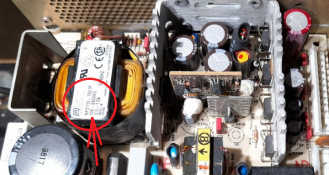NOON
Well-known member
Hi everyone! I just picked up a DBX RTA-1 real time analyzer for cheap. I can find very little about these online apart from that they were very well regarded. Mine is missing top and bottom of case and a few button caps but otherwise looks intact.
Very interesting beastie, it's based on a standard 8088 PC motherboard with 8 x 8bit ISA slots. It's got a built-in CRT, several ISA cards and a couple of other custom cards. The three 'digital' cards are a VGA card, what looks like a serial card with a couple of 16550 UART chips and a custom card that seems to have the RTC (real-time clock) and a bit of interconnecting logic between systems (e.g. VGA card and built-in monitor). There's an empty slot marked 'printer' on the back that I assume used to house a parallel port card.
Two other full length ISA cards have loads of analogue circuitry involving lots of DBX VCAs among other things. The sections are marked with frequencies so I assume these are the analogue filters. There's a big board attached to one side of the case that appears to serve the mic ins on the front and the analogue outs on the back. There's another small board that attaches to the power supply that has power out connections to the various sections as well as a small bit of circuitry that includes a 555 and a regulator, so I assume some kind of charge pump for the phantom power.
The switchmode power supply was hanging loose in the case (luckily didn't break the CRT during shipping!). Even though the back of the case has a 115/230V switch, it's been disconnected internally and the PSU has a big sticker saying 115V, even though it looks original to the chassis. Unfortunately I'm in a 230V country.
As far as I can tell from a good look around inside everything is there, all the cables seem obvious were they go with no mysteries and I can't see any evidence of smoke escaping, corrosion or other damage. Basically about as good as you can hope for with something of this age and unknown provenance.
I worked in IT in the 90s so I've got some familiarity with working on PCs of this vintage, although not so much with restoration of them when they're more than 30 years old! I'm sure the internet will be full of vintage computer nerds with tips though, the real problem is going to be the custom stuff.
I can't even find a user manual for these things let alone schematics or a service manual. I've emailed DBX, a local dealer and a guy who came up in a search as having done some software development for these back in the day but haven't heard back yet. I'm hoping someone here has some information stored away somewhere in their archives or memories on these things.
Very interesting beastie, it's based on a standard 8088 PC motherboard with 8 x 8bit ISA slots. It's got a built-in CRT, several ISA cards and a couple of other custom cards. The three 'digital' cards are a VGA card, what looks like a serial card with a couple of 16550 UART chips and a custom card that seems to have the RTC (real-time clock) and a bit of interconnecting logic between systems (e.g. VGA card and built-in monitor). There's an empty slot marked 'printer' on the back that I assume used to house a parallel port card.
Two other full length ISA cards have loads of analogue circuitry involving lots of DBX VCAs among other things. The sections are marked with frequencies so I assume these are the analogue filters. There's a big board attached to one side of the case that appears to serve the mic ins on the front and the analogue outs on the back. There's another small board that attaches to the power supply that has power out connections to the various sections as well as a small bit of circuitry that includes a 555 and a regulator, so I assume some kind of charge pump for the phantom power.
The switchmode power supply was hanging loose in the case (luckily didn't break the CRT during shipping!). Even though the back of the case has a 115/230V switch, it's been disconnected internally and the PSU has a big sticker saying 115V, even though it looks original to the chassis. Unfortunately I'm in a 230V country.
As far as I can tell from a good look around inside everything is there, all the cables seem obvious were they go with no mysteries and I can't see any evidence of smoke escaping, corrosion or other damage. Basically about as good as you can hope for with something of this age and unknown provenance.
I worked in IT in the 90s so I've got some familiarity with working on PCs of this vintage, although not so much with restoration of them when they're more than 30 years old! I'm sure the internet will be full of vintage computer nerds with tips though, the real problem is going to be the custom stuff.
I can't even find a user manual for these things let alone schematics or a service manual. I've emailed DBX, a local dealer and a guy who came up in a search as having done some software development for these back in the day but haven't heard back yet. I'm hoping someone here has some information stored away somewhere in their archives or memories on these things.































![Soldering Iron Kit, 120W LED Digital Advanced Solder Iron Soldering Gun kit, 110V Welding Tools, Smart Temperature Control [356℉-932℉], Extra 5pcs Tips, Auto Sleep, Temp Calibration, Orange](https://m.media-amazon.com/images/I/51sFKu9SdeL._SL500_.jpg)









